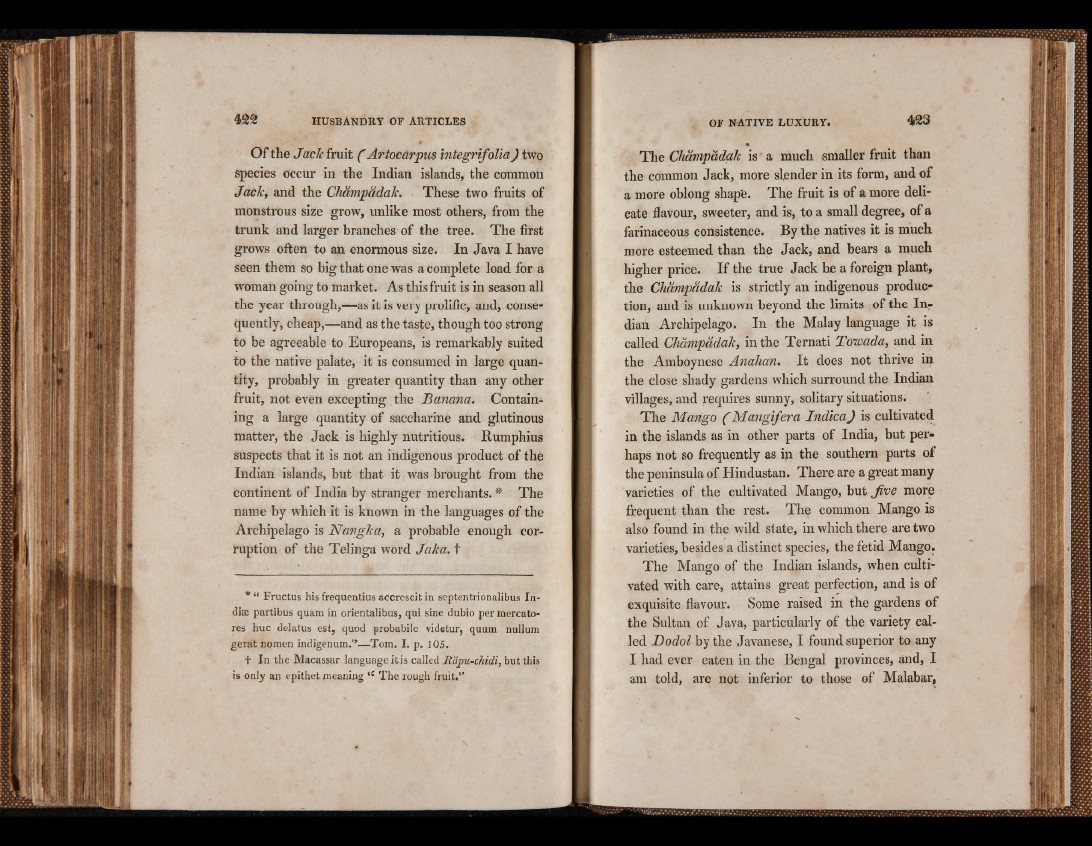
Of the Jack fruit ( Artocdrpus integrifolia) two
species occur in the Indian islands, the common
Jack, and the Champadak. These two fruits of
monstrous size grow, unlike most others, from the
trunk and larger branches of the tree. The first
grows often to an enormous size. In Java I have
seen them so big that one was a complete load for a
woman going to market. As this fruit is in season all
the year through,—as it is very prolific, and, consequently,
cheap,—and as the taste, though too strong
to be agreeable to Europeans, is remarkably suited
to the native palate, it is consumed in large quantity,
probably in greater quantity than any other
fruit, not even excepting the Banana. Containing
a large quantity of saccharine and glutinous
matter, the Jack is highly nutritious. Rumphius
suspects that it is not an indigenous product of the
Indian islands, but that it was brought from the
continent of India by stranger merchants. * The
name by which it is known in the languages of the
Archipelago is Nangka, a probable enough corruption
of the Telinga word Jaka. t
* “ Fructus his frequentius accrescit in septentrionalibus In-
dlas partibus quam in orientalibus, qui sine dubio per mercato-
res hue delatus est, quod probabile videtur, quum nullum
gerat nomen indigenum.”—Tom. I. p. 105.
+ In the Macassar language it is called Rapu-chidi, but this
is only an epithet meaning ,c The rough fruit.’'
m
The Champadak is a much smaller fruit than
the common Jack, more slender in its form, and of
a more oblong shape. The fruit is of a more delicate
flavour, sweeter, and is, to a small degree, of a
farinaceous consistence. By the natives it is much
more esteemed than the Jack, and bears a much
higher price. If the true Jack be a foreign plant,
the Champadak is strictly an indigenous production,
and is unknown beyond the limits of the Indian
Archipelago. In the Malay language it is
called Champadak, in the Ternati Towada, and in
the Amboynese Anahan. It does not thrive in
the close shady gardens which surround the Indian
villages, and requires sunny, solitary situations.
The Mango ( Mangifera Indica) is cultivated
in the islands as in other parts of India, but perhaps
not so frequently as in the southern parts of
the peninsula of Hindustan. There are a great many
varieties of the cultivated Mango, but jive more
frequent than the rest. The common Mango is
also found in the wild sl ate, in which there are two
varieties, besides a distinct species, the fetid Mango.
The Mango of the Indian islands, when cultivated
with care, attains great perfection, and is of
exquisite flavour. Some raised in the gardens of
the Sultan of Java, particularly of the variety called
Dodol by the Javanese, I found superior to any
I had ever eaten in the Bengal provinces, and, I
am told, are not inferior to those of Malabar,